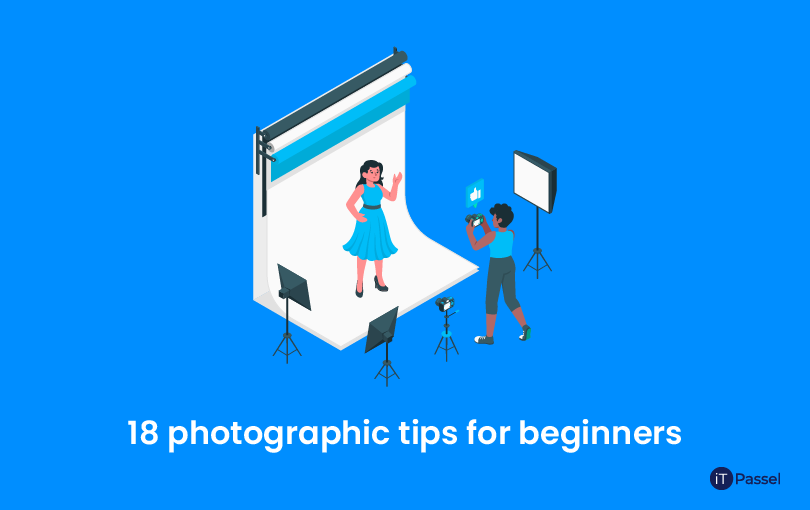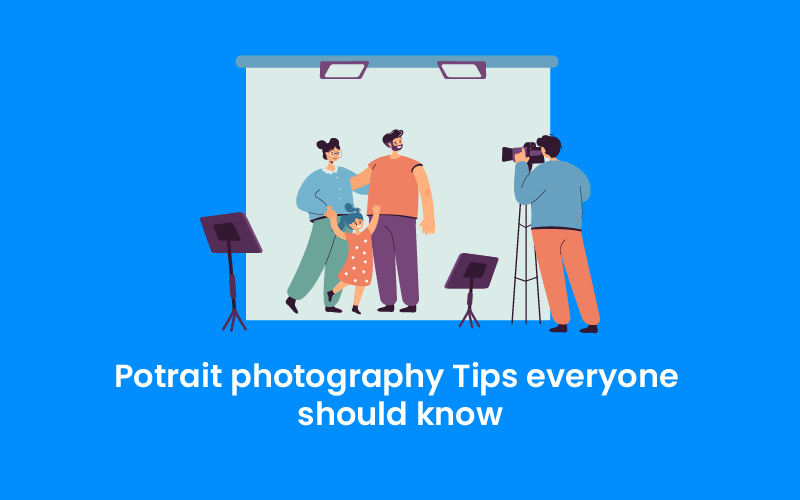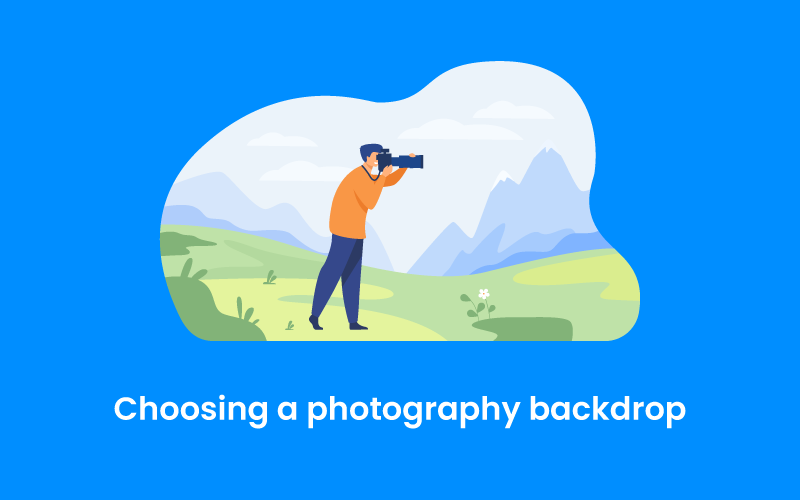We use cookies to make your experience better. To comply with the new e-Privacy directive, we need to ask for your consent to set the cookies. Learn more.
18 photographic tips for beginners

Whenever I get an idea for valuable photography advice. I write it down. Most of them are forgotten, but a few are so useful that I attempt to notify as many photographers as possible about them. There are 18 of the greatest in this article. These quick photography tutorials cover everything from novice camera technique to creativity and composition in bite-sized chunks. If you're just getting started with photography, they should come in handy.
List of 18 photographic tips for beginners:
- Make Use of Your Composition
- Make use of the camera you already own
- Find out which settings are important
- Highlights should not be overexposed
- Take Notice of the Light
- Please take your time
- Your Feet Should Be Moving
- When Should You Use a Tripod?
- When Should You Use a Flash?
- Clean the Lens of Your Camera
- Use a High-Quality Filter Instead of a Low-Quality Filter
- Learn the fundamentals of post-production
- Make a copy of your photos
- Organize Yourself
- Attempt Something Diverse
- Other Photographers to Meet
- Repair Your Weak Spots
- Examine Your Old Photographs
Make Use of Your Composition
To capture captivating images, you must be fully immersed in the task at hand. Don't just coast through life on autopilot. Instead, think about your composition and strive to produce the best images you can.
Knowing the fundamentals of how to create good photographs is the first step. Don't use the edge of your frame to cut out key sections of your subject. Keep your horizons level, and modify your composition to remove any distracting elements from your shot. Examine your photograph for balance and simplicity. And if your first attempt at a photo doesn't turn out well, keep experimenting until you get it right.
Make use of the camera you already own
The equipment you use with your camera isn't all that significant. Today's market is flooded with cameras, lenses, and other equipment. At Photography Life, we spend a lot of time reviewing them, and it's true that some are better than others (or better suited for a given job). However, if you've tried enough of them, you'll realize that almost everything nowadays is fantastic. Almost often, the variations are modest, especially at a given price.
So, don't look back and use the camera you already have. In practically every regard, today's entry-level DSLRs are superior to the best film SLRs of the past. Nonetheless, those film photographers were able to produce stunning, iconic images that are still lovely today.
Find out which settings are important
There are a lot of camera settings, and getting them perfect takes some experience, especially if you're a newbie. Even the most skilled photographers are not always able to achieve perfection. However, understanding how to correctly configure your camera and which camera settings are most important will give you the best chance of getting the photographs you desire. To begin, experiment with camera modes other than full Auto. If your camera makes all the decisions for you, you won't learn anything. It may seem perplexing at first, but our articles on aperture, shutter speed, and ISO should help you get started. In all of the photography, those are the three most critical settings. For fixed subjects, you'll usually prefer single-servo autofocus (also known as One-Shot AF), while for moving subjects, you'll probably prefer continuous-servo autofocus (also known as AI Servo). Unless it's so dark that autofocus isn't working, use manual focus.
Finally, shoot in RAW if you intend to modify your photographs or believe you may in the future. JPEGs look great right out of the camera, but they offer a lot less post-processing flexibility.
Highlights should not be overexposed
It's crucial to prevent overexposing highlights in a photograph when choosing camera settings. What is the explanation behind this? It's hard to retrieve any detail from a photo's white parts. Personally, I like a sky with structure and color in my shots rather than a large, featureless blob, and I'm sure you do as well. It's quite simple to save your highlights. However, here is when shutter speed, aperture, and ISO become crucial. These are the only camera settings that have a direct impact on a photo's brightness (ignoring flash settings, of course). Even exposure compensation, which is an essential setting in and of itself, just instructs your camera to alter one or more of these three factors.
Keep an eye on the camera screen when shooting images to determine if there is any overexposure. If this is the case, the first thing you need to do is reset your ISO to its default setting (usually ISO 100). Use a quicker shutter speed if it's already there. That should solve the problem. Make sure your aperture isn't set to a ridiculous setting (f/32, f/45, etc.).
Take notice of the light
Light is, without a doubt, the most crucial aspect of photography. If you shoot a photograph in good light, you've already gone a long way toward capturing a decent shot. But what exactly qualifies as decent lighting? Sunsets aren't the only thing to look forward to. The idea is usually to achieve a balance of light intensity between your subject and the background. Even if you're capturing a beautiful sunset, a fully black and silhouetted foreground might destroy the image.
The simplest solution is to pay attention to the light's direction and softness. If the light is excessively bright, you risk getting terrible shadows over your subject, which is especially problematic when photographing people. if you want any kind of Photo Editing Services you can visit ITPassel.com
Please take your time
It’s easy to make mistakes in photography if you aren’t careful. The best way around this is to slow down and take your time whenever possible, particularly when you are first beginning to learn photography.
First, double-check your camera settings. If you’re shooting outdoor portraits on a sunny day, but you’re using last night’s settings for photographing the Milky Way, something is terribly wrong. Slow down and take the time to get it right.
Your Feet Should Be Moving
While photographing, it's easy to become caught in one spot. Don't be caught in that trap. Instead, make as much movement with your feet (or your tripod) as feasible. Climb on top of items, adjust the camera's height, move forward and backward whatever it takes to stay moving. Guess what happens if you snap a dozen shots from the same height, looking the same direction, and you don't move your feet or tripod at all? They won't be that dissimilar. You're losing out on some fantastic photographs if your whole portfolio is shot from the same height and without any experimenting. Because a tripod might slow you down, event photography and action photography are slightly different. It's the same with vacation photography; as much as you would want to bring a tripod with you, it might not be worth the trouble.
That's understandable, but keep in mind that you're missing out if you leave your tripod at home. If I had to choose between an entry-level DSLR plus a tripod and the greatest camera/lens combination on the market without one, I'd go with the tripod package every time.
When should you use Tripod?
Flashes aren't just for low-light situations. Don't get me wrong: if you need some extra light, they're fantastic. Invest in an external flash, point it at the ceiling, and use a lens that is quite long (50mm or longer). The quality of your event images will wow everyone you know. It's the simplest technique to achieve good outcomes without having any prior knowledge of the subject. Outdoors, too, flashes are handy, even in the middle of the day. This is why "fill flash" is so crucial if you've ever heard of it. By employing a moderate flash, you can fill up unattractive shadows on your subject, and most people looking at the shot won't notice.
Too many folks I've seen going about with their camera lens' front element unclean, dusty, and smeared. That's the quickest and most reliable technique to obtain blurry photographs every time.
When should you use a flash?
Of course, a speck of dust won't hurt anything, and it won't even show up in a picture. Every lens contains microscopic dust particles that are hard to remove without disassembling the lens and which have no effect on the image.
Instead, I'm referring to lenses that have never been cleaned and are covered with filth and fingerprints that haven't been removed in a long time. Get a microfiber cloth and lens cleaning solution for yourself. Take them with you on vacations and use them at least once a week.
Clean the lens of your camera
The second easiest way to get blurry photos 100% of the time is to use a cheap filter on the front of your lens. Personally, when I just started out in photography, my grandfather gave me an old, clear filter from his film camera. It fit my lens perfectly; I was so surprised that I kept it on my lens all the time, never worrying if the glass was up to today’s standards or not. Turns out that it wasn’t. The corners of all my photos were blurry, and any mild bright area in the photo (like the sky or a lamp at night) turned into a wicked flare.
Use a High-Quality Filter Instead of a Low-Quality Filter
Post-production isn't always at the top of a photographer's priority list, but it should be. A nice shot may sometimes be transformed into something absolutely outstanding with the correct post-processing. When post-processing, it's easy to go overboard, thus the most essential thing is to ensure sure none of your alterations are permanent (also known as "destructive editing"). To save your original files, use the Save As command, or better yet, edit in software that saves your changes in a separate file rather than baking them into the image.
The goal of post-processing is to create an atmosphere and guide the viewer's eye through an image. Over time, you'll grow better and better at this. What is my strongest recommendation? Be unobtrusive. You don't want your images to appear too manipulated.
Learn the fundamentals of post-production
Almost every photographer I know has misplaced key photographs at some point throughout their career. Allowing this to happen to you is not a good idea. To begin, make a backup of each and every one of your photographs. Your images should never be saved on a single hard disc at a time, as the hard drive will ultimately fail. It's a question of when not if.
At any one moment, you should have at least three copies of all your images. At least two separate media types, such as an internal hard drive and a detachable storage medium, should be included.
Make a copy of your photos
Almost every photographer I know has misplaced key photographs at some point throughout their career. Allowing this to happen to you is not a good idea. To begin, make a backup of each and every one of your photographs. Your images should never be saved on a single hard disc at a time, as the hard drive will ultimately fail. It's a question of when not if.
At any one moment, you should have at least three copies of all your images. At least two separate media types, such as an internal hard drive and a detachable storage medium, should be included.
Organize yourself
Almost every photographer I know has misplaced key photographs at some point throughout their career. Allowing this to happen to you is not a good idea. To begin, make a backup of each and every one of your photographs. Your images should never be saved on a single hard disc at a time, as the hard drive will ultimately fail. It's a question of when not if.
At any one moment, you should have at least three copies of all your images. At least two separate media types, such as an internal hard drive and a detachable storage medium, should be included.
Attempt something Diverse
Photography gets more exciting when you explore it. It's easy to become stuck in a rut and capture the same photographs over and over again, and there's nothing wrong with that, but it's also necessary to branch out every now and again.
Try your hand at macro photography or experiment with different lighting approaches. Experiment with different post-processing techniques. Drive to a spot you've never photographed before on the spur of the moment. There are a plethora of opportunities to attempt something new in photography, and you won't be disappointed if you do.
Other Photographers to Meet
Meeting other photographers is one of the best ways to keep learning and improving, either for inspiration or for advice. You’d be surprised how much people enjoy sharing their tips and techniques with other photographers. You’ll rarely encounter secrecy or disdain; even the great Ansel Adams wrote several books explaining his photographic techniques.
If you’re the type of person who prefers self-guided learning in photography, this still applies. Ask questions on online forums, email photographers whose work you admire, and otherwise save resources you find valuable. No matter what, don’t stop learning. There’s always more to learn.
Repair Your Weak Spots
It's tempting to retreat to Auto mode rather than practice what you don't grasp if you're still trying to get your brain around shutter speed, aperture, and ISO. That's a tremendous blunder!
If you're learning portrait photography and have trouble acquiring decent light from your flash, it might be tempting to shoot all of your interior photos near a window for great light. That is also a tremendous blunder! It's tempting to shoot all your photos in JPEG to get something excellent out of the camera if you're attempting to learn post-processing but your software is complicated. But you got it that's still another big blunder!
Examine Your Old Photographs
Many photographers, I've discovered, have a habit of taking images, selecting the finest from a session, and then seldom or never returning to the rest. However, there are a variety of reasons why your old, unused images are among your portfolio's most significant assets.
First and foremost, they assist you in correcting your flaws. Simply ask yourself why your terrible shots are bad on average. Perhaps you have a proclivity for focusing wrongly, exposing too darkly or brightly, composing awkwardly, and so forth. All of this is really helpful knowledge since it allows you to improve the problem in the future.




